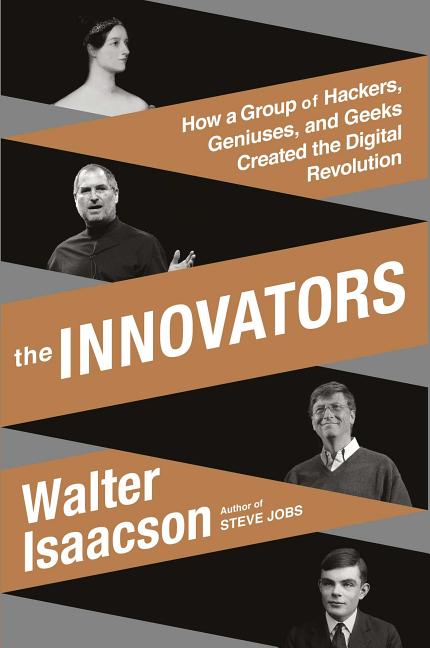The Innovators
October 29, 2014
Throughout The Innovators, Isaacson maintains a delicate balance between the drama of human relationships and the crucial technical details.
The Innovators: How a Group of Hackers, Geniuses, and Geeks Created the Digital Revolution by Walter Isaacson, Simon & Schuster, 560 pages, $35.00, Hardcover, October 2014, ISBN 9781476708690
In the introduction to The Innovators, Walter Isaacson briefly shares the story of the book’s completion and publication. The book has been over a decade in coming, says Isaacson, and its development was interrupted twice by focused biographies on Einstein and Steve Jobs. For the length and scope that The Innovators covers, its introduction is brief, but it shares some valuable insights into Isaacson’s vision.
[T]he collaborative creativity that marked the digital age included collaboration between humans and machines. The people who were comfortable at this humanities-technology intersection helped to create the human-machine symbiosis that is at the core of the story.
To give readers a complete background on the digital devices now ubiquitous in our daily lives, Isaacson must take us back over 150 years. Beginning with Lord Byron and his daughter Ada Lovelace, we start to see the first iterations of computing machines, programming, and a vision for computers—originating with the Countess of Lovelace—that brings programming and automation to more than simply mathematics, but to any operation that uses symbolic logic. Struggling tech startups of today might find resonance in the story of Charles Babbage’s difference engine, a mechanical calculator in which the British government invested over £17,000. Unfortunately, Babbage never finished the project—his investors pulled out before a working machine was completed.
These early chapters are possibly the most fascinating portion of the book, because so much of what Isaacson covers is unfamiliar territory for most readers. Almost all readers know Steve Jobs, Bill Gates, and Steve Wozniak, but these stars of our computer age began their work with over a century of work done by hundreds of other innovators. While many of the features we take for granted in modern devices today are relatively new on the market, the concepts that drive them have been passed back and forth since Babbage and Lovelace.
Throughout The Innovators, Isaacson remains true to his passion for the human-machine connection, maintaining a delicate balance between the drama of the human relationships and banalities that accompany them, and the crucial technical details that are the products and inventions that these people—the innovators—have created. The story is one about the ingenuity of people, but the structure of The Innovators is clearly driven by the innovations themselves.
Isaacson introduces us in chapter three to Grace Hopper. Hopper was instrumental in programming IBM’s Mark I, one of the first major electro-mechanical computers. On assignment from her supervisor Howard Aiken, Hopper wrote a 500-page hybrid document that proved both a history of and a manual for the Mark I. As Isaacson says, Hopper’s book focused on the individuals whose work contributed to the computer—these were the people who formed the history of the machine. IBM quickly replied by publishing its own history of the Mark I—and it was to the opposite extreme. This contrast is summed up in a line Isaacson quotes from Kurt Beyer’s study of Hopper.
The locus of technological innovation, according to IBM, was the corporation. The myth of the lone radical inventor working in the laboratory or basement was replaced by the reality of teams of faceless organizational engineers contributing incremental advancements.
Isaacson’s history is nowhere near “faceless,” but throughout the pages of his book, it becomes clear that he understands the importance of an innovator’s dependence upon peers and predecessors.
The Innovators divides digital computing’s more recent history into four chapters: the personal computer, software, online, and the web. It’s in these final chapters that we read the stories of the innovators so revered today, alongside some of the lesser-known contributors and casualties of the struggle toward universally-useful computer technologies. Isaacson’s history ends at search technology with Larry Page and Sergey Brin. Isaacson’s coverage does not go beyond web search—no big look at social media, mobile technology, or big data. Perhaps it’s too early to write the history on those developments. As it is, the breadth of The Innovators is beyond satisfying. Isaacson demonstrates the digital revolution—a revolution unlike anything else in recorded history—to be a global and complex collaboration between people and machines across a century and a half.



